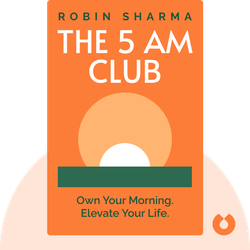Try Blinkist to get the key ideas from 7,000+ bestselling nonfiction titles and podcasts. Listen or read in just 15 minutes.
Start your free trial
Blink 3 of 8 - The 5 AM Club
by Robin Sharma

The Rise of the Intangible Economy
'Capitalism Without Capital' by Jonathan Haskel and Stian Westlake explains how the modern economy values intangible assets like ideas and relationships more than tangible ones, and how this shift is changing the way we live and work.
When William the Conqueror, ruler of late eleventh-century England, wanted an estimate of his kingdom’s wealth, he sent out surveyors. In towns and villages across the land, they talked to people, inspected buildings and property and counted animals. Outside of London, in the village of Stansted, which is today the site of a busy international airport, they recorded a mill, 60 pigs, three slaves and 16 cows. The village’s value was listed at £11 per year.
For centuries, the process of assessing value – of a business, a town or even a country – has involved measuring, counting and valuating physical, tangible things, like buildings, machinery or computers.
But economists are now catching up with an emerging reality. Intangible assets – things that we can neither see nor touch, but that are nonetheless valuable – are growing in economic importance.
To understand the rising importance of the intangible economy, imagine you find yourself in a 1970s supermarket. You probably wouldn’t feel too out of place, because, physically speaking, not much has changed in supermarkets in the past 50 years. Today’s supermarkets have aisles flanked by shelves coolers, freezers and checkout counters, just like those of half a century ago.
What’s changed for supermarkets is the incredible growth of intangible assets. Consider the rise of barcodes. They not only sped things up at the checkout, making it unnecessary for a worker to manually enter prices. They also enabled management to see, with the help of computer systems, and without a manual stock count, how many sales had been made, and what stock was in inventory. This, in turn, made it easier to manage stock, plan promotions and change prices without having to manually reprice every item.
This development greatly increased the productivity of supermarkets and enabled more complex and more profitable pricing systems. Supermarkets have also invested heavily in branding and marketing, two more key intangibles, boosted by data-driven loyalty-card systems.
Nowadays, the most valuable assets for many businesses are things we cannot touch. When Microsoft hit a market valuation of $250 billion in 2006 and became the most valuable company in the world at the time, the value of its traditional physical assets was a mere $3 billion – just 1 percent of its overall value. Businesses like Microsoft are hugely valuable, not because of the worth of their factories, or their machinery, or their warehouses. Rather, it’s because of their software, brand and intellectual property, and because the efficiency of their supply-chain organization means they can quickly get products to market.
Today, we’re experiencing an increasing disconnect as capitalism operates with less and less reliance on physical capital. Let’s explore a little how this change is taking place across the world.



Capitalism Without Capital (2017) is an account of the growing importance of the intangible economy. Today, for the first time, most developed economies are investing less in tangible, physical assets such as machinery and factories, than in intangible assets such as software, research and development capability. These intangibles are hugely valuable but do not exist in physical form. The blinks ahead explore the nature of this trend, as well as its effects on business, the economy and public policy.
Capitalism Without Capital (2017) explores the rise of the intangible economy and its implications for businesses and society. Here's why this book is worth reading:
It's highly addictive to get core insights on personally relevant topics without repetition or triviality. Added to that the apps ability to suggest kindred interests opens up a foundation of knowledge.
Great app. Good selection of book summaries you can read or listen to while commuting. Instead of scrolling through your social media news feed, this is a much better way to spend your spare time in my opinion.
Life changing. The concept of being able to grasp a book's main point in such a short time truly opens multiple opportunities to grow every area of your life at a faster rate.
Great app. Addicting. Perfect for wait times, morning coffee, evening before bed. Extremely well written, thorough, easy to use.
Try Blinkist to get the key ideas from 7,000+ bestselling nonfiction titles and podcasts. Listen or read in just 15 minutes.
Start your free trial
Blink 3 of 8 - The 5 AM Club
by Robin Sharma
What is the main message of Capitalism Without Capital?
The main message of Capitalism Without Capital is about the rise of intangible assets in the modern economy.
How long does it take to read Capitalism Without Capital?
The reading time for Capitalism Without Capital varies depending on the reader, but it typically takes several hours. However, the Blinkist summary can be read in just 15 minutes.
Is Capitalism Without Capital a good book? Is it worth reading?
Capitalism Without Capital is a must-read for anyone interested in understanding the changing nature of the economy. It offers fascinating insights and analysis.
Who is the author of Capitalism Without Capital?
The authors of Capitalism Without Capital are Jonathan Haskel and Stian Westlake.